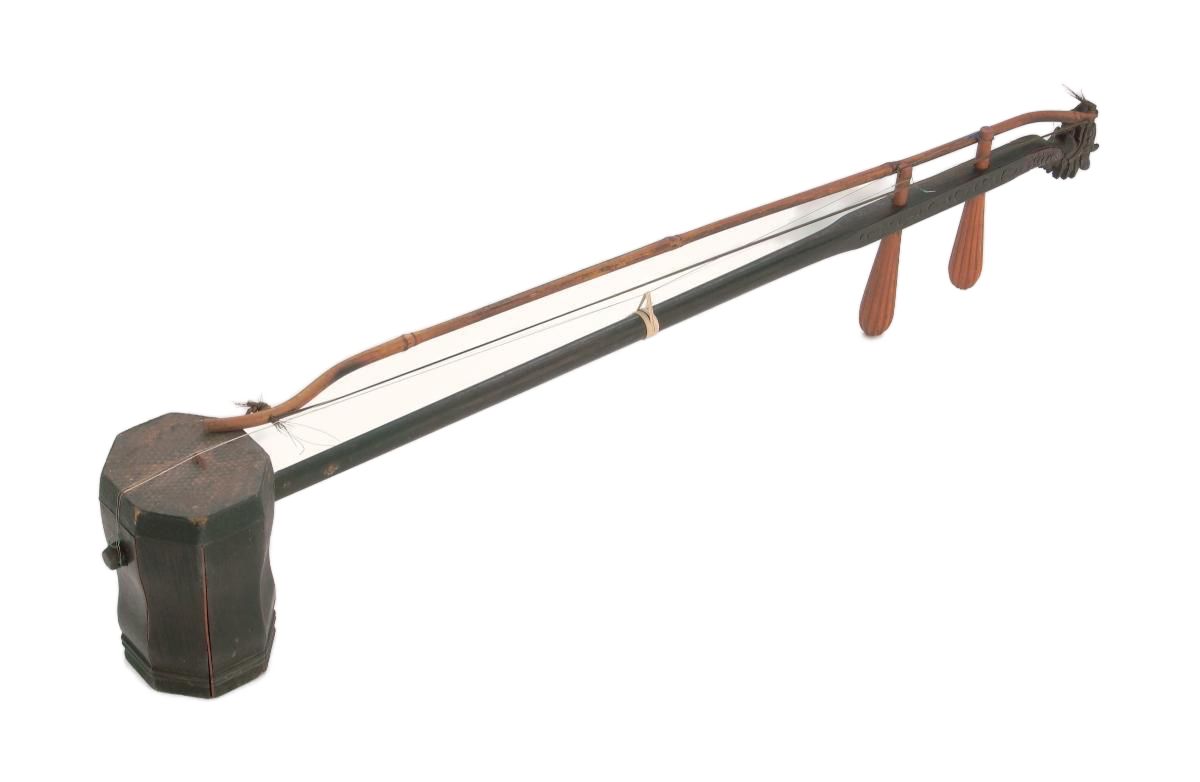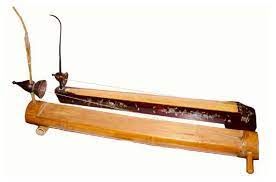MONOCHORDS
The monochord was used in Greece by the 6th century bc as a scientific instrument for measuring musical intervals. Knowledge of the instrument was transmitted to medieval theorists by the 5th-century-ad philosopher Boethius; the first treatises on it date from the 10th century.
Using this instrument, Pythagoras discovered the consonant musical intervals. Eventually, the monochord would help him put together a theory of the world’s inner workings–the universe could be understood through harmony and mathematical ratios.
In the 11th century, Guido of Arezzo used the monochord to teach choirs to sing and chant. The tool was also useful for detecting incorrect pitches and tuning other instruments.
Pythagoras - inventor of so much
“There is geometry in the humming of the strings. There is music in the spacing of the spheres. ” – Pythagoras, Greek philosopher (570 – 495 B.C.)
This is a replica of the Monochord of Pythagoras, named after the famous Greek philosopher from Samos, who reinvented it during the sixth century B.C. As Aristotle once wrote, “the Pythagoreans construct the whole universe out of numbers”, and this is why “music, mathematics, and astronomy were inexorably linked in the monochord” (Siemen, 1993).
The monochord is an ancient sonometer, musical, and scientific laboratory instrument that is ideal to demonstrate the relationship between the frequency of the sound produced by a plucked string, and its length. “With its single string, movable bridge and graduated rule, the monochord straddled the gap between notes and numbers, intervals and ratios, sense-perception and mathematical reason” according to Dr. Creese, Assistant Professor at the University of British Columbia.
LUTHIEROS Monochord of Pythagoras consists of a rectangular soundbox with a wooden soundboard, one fixed bridge, and one movable bridge, along with a single gut string. According to modern lyre instructors, it is the ideal educational instrument to deeply understand how the harmonics are produced. What’s more, it is an excellent pedagogical tool for demonstrating mathematical relationships between intervals.New Paragraph
To explore more abut Pythagoras and his Monochords, click HERE to see what UNESCO has written about the Kanon of Pythagoras (7th c BC)
The Chinese Duxianqin
Duxianqin, or one-string dulcimer, is a traditional musical instrument of the Jing ethnic group. As its name suggests, the old musical instrument — with a history dating to the 8th century — has only one string and is capable of producing two different sounds at the same time.
The performers usually hold the instrument with their left hand and pluck the string with a tiny piece of bamboo with their right. While plucking the instrument's string, the performers simultaneously control the pitch by moving a "wand" which protrudes upward, to adjust the tension on the string.
Su Haizhen grew up listening to the unique musical instrument, which is often performed as an accompaniment to folk songs of the Jing ethnic group and during its traditional folk festivals.
"The sounds of duxianqin are similar to the pronunciation of Jing language, which is both soft and produces a strong nasal tone. I always feel close to the musical instrument," says Su.
She started learning to play duxianqin at 8 years old. Now, as an inheritor of the musical instrument, which was listed as a part of China's national intangible cultural heritage in 2011, Su is the head of Dongxing Jing Ecomuseum, which is located in Jiangping town, Dongxing, Guangxi Zhuang autonomous region. Founded in 2008, the ecomuseum is dedicated to preserving and promoting the history and culture of the Jing ethnic group.
Among China's ethnic groups, the Jing people are the only group known for their marine culture, with a small population of about 30,000. The majority of the population live on three islands in Dongxing: Wanwei, Wutou and Shanxin.

Vietnamese Dan Bau
Believed to be as old as Vietnams’ early dynastic era, an extraordinary musical instrument exists through time holding with it centuries of beautiful music incorporated into lifelong histories of lives of the Vietnamese people. The Dan Bau is known to create soft, serene sounds, which, every melody produced by it embodies the beauty of the country and its people. One of the only two musical instruments thought to be of pure Vietnamese origin, the Dan Bau is the unequivocal presentation of the country’s unique culture.
Legends talk of a blind woman playing sweet music from the instrument as a means of living while her husband’s at war. That, they say, was the beginning of how the instrument was discovered and the unmistakable emotional appeal of its melody began to be appreciated. Though there’s not much to substantiate such story, one thing’s for sure, the sounds produced by the Dan Bau sends a powerful message of love, longing and beauty that never cease to evoke the hearts and souls of its listeners.
A single-stringed musical instrument, the Dan Bau is simple yet very unique. Đàn, meaning a stringed instrument, and bầu, which means gourd, the device is exactly what is says. In general, it consists of a few components which includes the soundboard serving as its resonator, the spout, gourd, string and a tuning peg. Though originally, the instrument is made of four parts: a bamboo tube, a wooden rod, a coconut shell half, and a silk string. The string runs across the bamboo and secured on one end to the rod, which is perpendicularly attached to the bamboo.
Present day Dan Baus are constructed using wooden soundboards in place of the bamboo. The traditional silk string have also been replaced with an iron string. The instrument’s spout, which is a flexible rod that varies the string’s tension, is made of buffalo horn that is square-framed at the root, while flat and gradually bent at the top. It plays an important role in producing sounds of different pitches beyond fundamental overtones of the instrument. The gourd used to cover the spout where the string is tied, acting as a resonator, still exists though it had been replaced by wood and serves nothing more than a decorative feature. Its tuning peg, which could be made of bamboo or wood, is located at the inside frame towards the bottom of the wooden soundboard. The iron string goes through a small hole at the end of the instrument's surface towards the tuning peg. A pointed stick made of bamboo or rattan is commonly used as pluck for this instrument.
Most of Dan Baus today now have modern tuning machines to allow adjustments of the string’s base pitch. Usually tuned to the C note, it uses harmonies or overtones. It is played by plucking the strings while touching it lightly with the side of the hand at a point producing a harmony. Though it does not require for one to be highly skilled in order to play the Dan Bau, a great deal of precision is needed to allow rise and fall of pitch along with lengthening and shortening of the notes with the aid of the flexible rod that permits the shifting tension of the string, thus, trills could be played. The technique involves gently tapping the string with the tiny finger of the right hand while the other fingers pluck the string using a long plectrum. With the left hand, the note’s pitch could be lowered by pushing the flexible rod using the index finger, or pulling the rod away with the thumb if a higher pitch is desired.
Used to be played solo or along poetry recitals, the instrument had now taken part in large orchestra to accompany stage operas. Music incorporating Dan Bau with their songs have taken a huge turn beginning the 20th century where players infused electrical pickups and amplifiers with the instrument to make its sound more distinct and audible to larger audiences. Still, solo performances are greatly appreciate and musical pieces exclusively composed for Bau solo, such as Vu Khuc Tay Nguyen (Dance of the Central Highland) by Duc Nhuan, Dong kenh trong (The clear channel) by Hoang Dam and Vi Mien Nam (for the South) by Huy Thuc are widely applauded.
Likened to the monochords of other parts the world, along which are the Tuntina of India, Cung of East Africa, Duxiangin of China, none can compare to the serene, melodious and inspiring tunes that reaches out to the emotions to wherever the wind carries its sound. Every pluck of the Dan Bau’s string is a tale of love and history in itself touching every listener’s heart while stirring their souls. The melody produced by the instrument may be viewed differently by every person as he connects with his own feelings. No matter how re-lived over the periods, and how time changed its visage, Dan Bau is one instrument that translates a great part of Vietnam and a true expression of emotions that will forever transcend time.New Paragraph


